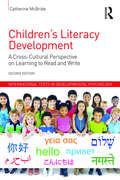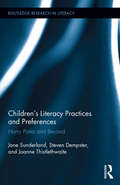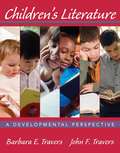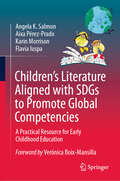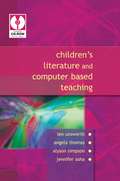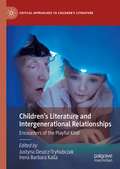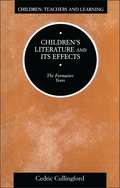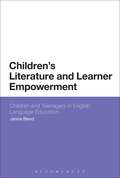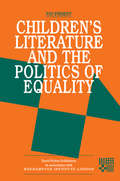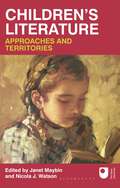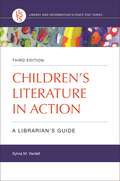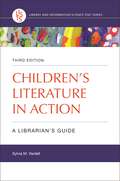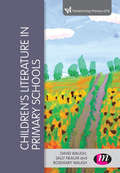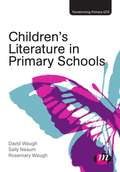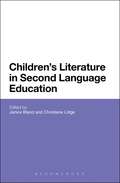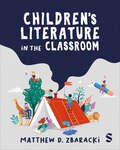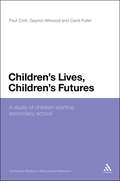- Table View
- List View
Children's Literacy Development: A Cross-Cultural Perspective on Learning to Read and Write (International Texts in Developmental Psychology)
by Catherine McBrideIn the thoroughly updated second edition of this unique book, Catherine McBride examines how the languages we know help structure the process of becoming literate. Taking an ecological and distinctively cross-cultural perspective, the book looks at reading and writing development and impairment across a range of languages, scripts, and contexts. The book covers issues including: The importance of phonological sensitivity for learning to read and to write The first units, or building blocks, of literacy learning in different scripts such as Chinese, English, Korean Hangul, Hebrew, Hindi and Arabic The role of visual processing in reading and writing skills How the latest research can inform the teaching of reading An overview of our understanding of dyslexia, including recent neuroscientific research The developmental challenges in becoming biliterate What is special about writing for beginners and later for comprehensive writing Basics of reading comprehension Children’s Literacy Development, Second Edition is a timely and important contribution to our understanding of literacy around the world. Written by an eminent scholar in the field, it is the only book available that provides an overview of how children learn to read and write in different languages, and will be essential reading for all students of Developmental Psychology, Educational Psychology, Psycholinguistics and Speech Therapy.
Children's Literacy Development: A Cross-Cultural Perspective on Learning to Read and Write (International Texts in Developmental Psychology)
by Catherine McBrideIn the thoroughly updated second edition of this unique book, Catherine McBride examines how the languages we know help structure the process of becoming literate. Taking an ecological and distinctively cross-cultural perspective, the book looks at reading and writing development and impairment across a range of languages, scripts, and contexts. The book covers issues including: The importance of phonological sensitivity for learning to read and to write The first units, or building blocks, of literacy learning in different scripts such as Chinese, English, Korean Hangul, Hebrew, Hindi and Arabic The role of visual processing in reading and writing skills How the latest research can inform the teaching of reading An overview of our understanding of dyslexia, including recent neuroscientific research The developmental challenges in becoming biliterate What is special about writing for beginners and later for comprehensive writing Basics of reading comprehension Children’s Literacy Development, Second Edition is a timely and important contribution to our understanding of literacy around the world. Written by an eminent scholar in the field, it is the only book available that provides an overview of how children learn to read and write in different languages, and will be essential reading for all students of Developmental Psychology, Educational Psychology, Psycholinguistics and Speech Therapy.
Children's Literacy Practices and Preferences: Harry Potter and Beyond (Routledge Research in Literacy)
by Jane Sunderland Steven Dempster Joanne ThistlethwaiteOver the past few decades there have been intense debates in education surrounding children’s literacy achievement and ways to promote reading, particularly that of boys. The Harry Potter book series has been received enthusiastically by very many children, boys and girls alike, but has also been constructed in popular and media discourses as a children’s, particularly a boys’, literacy saviour. Children’s Literacy Practices and Preferences: Harry Potter and Beyond provides empirical evidence of young people’s reported literacy practices and views on reading, and of how they see how the Harry Potter series as having impacted their own literacy. The volume explores and debunks some of the myths surrounding Harry Potter and literacy, and contextualizes these within children’s wider reading.
Children's Literacy Practices and Preferences: Harry Potter and Beyond (Routledge Research in Literacy #8)
by Jane Sunderland Steven Dempster Joanne ThistlethwaiteOver the past few decades there have been intense debates in education surrounding children’s literacy achievement and ways to promote reading, particularly that of boys. The Harry Potter book series has been received enthusiastically by very many children, boys and girls alike, but has also been constructed in popular and media discourses as a children’s, particularly a boys’, literacy saviour. Children’s Literacy Practices and Preferences: Harry Potter and Beyond provides empirical evidence of young people’s reported literacy practices and views on reading, and of how they see how the Harry Potter series as having impacted their own literacy. The volume explores and debunks some of the myths surrounding Harry Potter and literacy, and contextualizes these within children’s wider reading.
Childrens Literature: A Developmental Perspective
by Barbara E. Travers John F. TraversThis book takes a developmental approach to children's literature, offering a fresh perspective in the field. By combining children's literature with developmental psychology, future teachers and librarians will have a better understanding of the appropriate book for a child at a certain stage of their life. Each genre is covered within a chapter devoted to a certain developmental stage.
Children’s Literature Aligned with SDGs to Promote Global Competencies: A Practical Resource for Early Childhood Education
by Angela K. Salmon Aixa Pérez-Prado Karin Morrison Flavia IuspaThis book presents children’s literature as a platform for learning and helping young readers develop the knowledge, skills, and attitudes needed to thrive in an interconnected and diverse global society. It draws from various theoretical frameworks and research findings to implement critical literacy and culturally responsive teaching in the meaning-making process.The book focuses on global competencies and Sustainable Development Goals (SDGs) as intertwined concepts that work together to foster a more sustainable, inclusive, and equitable world. Developing global competencies empowers children and communities to actively participate in achieving the SDGs and addressing the pressing challenges of our time. The authors set high expectations on children as actors in transforming society. To facilitate this, the book offers an overview of child development theories as a foundation for designing developmentally appropriate practices to extend children’s books toward deep thinking and understanding. The book includes sample lessons that use cutting-edge research-based pedagogies and tools such as visible thinking routines and other approaches. Those lessons also help readers identify the Habits of Mind (HOM) children can develop by listening to and discussing stories. The HOM are attributes of good problem-finders and problem-solvers needed when confronting complex issues. The book provides resources and sample lessons that implement different thinking strategies to engage children in questioning and analyzing what they read, making them more critical. This is how children deeply understand the world and their role in creating positive change. The book aims to cultivate change-makers and global citizens through stories. It offers innovative approaches, including online learning options in accessible and engaging ways to help children think globally and act locally‘Through the power of children’s literature, this book serves a larger agenda: To build a more thoughtful world for future generations. By caring for and learning from one another through suggested activities in this book, they will share the riches and resources from across the world. As children learn about the promise of actions toward the UN Sustainable Goals, they can imagine living in an interdependent learning community where all people continually searching for ways to trust each other, learn together, and grow toward greater intelligence.’ Arthur Costa and Bena Kallick, Co-Founders and Directors of The Institute for Habits of Mind
Children's Literature and Computer Based Teaching (UK Higher Education OUP Humanities & Social Sciences Education OUP)
by Len Unsworth Angela Thomas Alyson Simpson Jennifer Asha“This stellar book extends teachers’ thinking well beyond 'book spaces' and into 'digital spaces' by offering theorized approaches to analyzing children’s literature across media, and careful descriptions of effective learning activities that are rich in detail and practical advice. This book (and its digital spaces) is an indispensable guide to engaging with children’s literature and new digital media.”Michele Knobel, Montclair State University, USA.“The book overall is exciting, informative and practical, outlining important theoretical perspectives and ideas while also providing much wisdom and advice to teachers about how to transform their literary programs.”Frances Christie, Emeritus Professor of Language andLiteracy Education, University of Melbourne and HonoraryProfessor of Education, University of Sydney, Australia.This book connects classroom teaching of children’s literature with the digital age. It celebrates the charm of children’s literature and its role in literacy development, as well as the appeal of information and communications technology (ICT) to students and its capacity to enrich students’ learning and enjoyment of literary texts.The authors outline the ways in which children’s literature is developing new dimensions, for example:The re-publication of children’s books on CD ROM and the world wide webWeb resources for working with literary texts, including e-mail discussion groupsChildren’s participation in the collaborative construction of online narrativesThe book provides practical guidance for teachers who areinexperienced with ICT. It describes and discussesimplementation of activities that extend traditional approaches toliterary texts and take advantage of available technology.
Children’s Literature and Intergenerational Relationships: Encounters of the Playful Kind (Critical Approaches to Children's Literature)
by Justyna Deszcz-Tryhubczak Irena Barbara KallaChildren’s Literature and Intergenerational Relationships: Encounters of the Playful Kind explores ways in which children’s literature becomes the object and catalyst of play that brings younger and older generations closer to one another. Providing examples from diverse cultural and historical contexts, this collection argues that children’s texts promote intergenerational play through the use of literary devices and graphic formats and that they may prompt joint play practices in the real world. The book offers a distinctive contribution to children’s literature scholarship by shifting critical attention away from the difference and conflict between children and adults to the exploration of inter-age interdependencies as equally crucial aspects of human life, presenting a new perspective for all who research and work with children’s culture in times of global aging.
Children's Literature and its Effects
by Cedric CullingfordA study of children's authors who are typical of their time, such as Enid Blyton, Angela Brazil, Judy Blume and Ronald Dahl. The book discusses comics as well as "classic" texts, and the possible effects of these materials on children's attitudes.
Children's Literature and Learner Empowerment: Children and Teenagers in English Language Education
by Janice BlandChildren's literature can be a powerful way to encourage and empower EFL students but is less commonly used in the classroom than adult literature. This text provides a comprehensive introduction to children's and young adult literature in EFL teaching. It demonstrates the complexity of children's literature and how it can encourage an active community of second language readers: with multilayered picturebooks, fairy tales, graphic novels and radical young adult fiction. It examines the opportunities of children's literature in EFL teacher education, including: the intertexuality of children's literature as a gate-opener for canonised adult literature; the rich patterning of children's literature supporting Creative Writing; the potential of interactive drama projects. Close readings of texts at the centre of contemporary literary scholarship, yet largely unknown in the EFL world, provide an invaluable guide for teacher educators and student teachers, including works by David Almond, Anthony Browne, Philip Pullman and J.K.Rowling. Introducing a range of genres and their significance for EFL teaching, this study makes an important new approach accessible for EFL teachers, student teachers and teacher educators.
Children's Literature and Learner Empowerment: Children and Teenagers in English Language Education
by Janice BlandChildren's literature can be a powerful way to encourage and empower EFL students but is less commonly used in the classroom than adult literature. This text provides a comprehensive introduction to children's and young adult literature in EFL teaching. It demonstrates the complexity of children's literature and how it can encourage an active community of second language readers: with multilayered picturebooks, fairy tales, graphic novels and radical young adult fiction. It examines the opportunities of children's literature in EFL teacher education, including: the intertexuality of children's literature as a gate-opener for canonised adult literature; the rich patterning of children's literature supporting Creative Writing; the potential of interactive drama projects. Close readings of texts at the centre of contemporary literary scholarship, yet largely unknown in the EFL world, provide an invaluable guide for teacher educators and student teachers, including works by David Almond, Anthony Browne, Philip Pullman and J.K.Rowling. Introducing a range of genres and their significance for EFL teaching, this study makes an important new approach accessible for EFL teachers, student teachers and teacher educators.
Childrens Literature and the Politics of Equality (Language And Literacy Ser.)
by Pat PinsentFirst published in 1997. Routledge is an imprint of Taylor & Francis, an informa company.
Childrens Literature and the Politics of Equality
by Pat PinsentFirst published in 1997. Routledge is an imprint of Taylor & Francis, an informa company.
Children's Literature: Approaches and Territories
by Janet Maybin Nicola J. WatsonHow has children's literature been defined? In what ways has it changed over time? How are the classics of children's literature established? What is the impact of digital media and globalization on books for children?Children's Literature: Approaches and Territories provides a social and literary overview of the field of Anglophone children's literature: its history and genres, its current concerns and its possible future directions. Emphasising how children's literature is embedded in the social life of children and adults, the collection brings together lively and accessible scholarly essays by leading scholars, some reprinted and others newly commissioned. It includes sections on poetry, drama and picture books and is supported by detailed introductory material, suggestions for further reading and a colour plate section reproducing illustrations from key children's texts.
Children's Literature in Action: A Librarian's Guide (Library and Information Science Text Series)
by Sylvia M. VardellThis practitioner-oriented introduction to literature for children ages 5–12 covers the latest trends, titles, and tools for choosing the best books and materials as well as for planning fun and effective programs and activities.The third edition of Children's Literature in Action provides an activity-oriented survey of children's literature for undergraduate and graduate students seeking licensure and degrees that will lead to careers working with children in schools and public libraries. Author Sylvia M. Vardell draws on her 30 years of university teaching and extensive familiarity with the major textbooks in the area of children's literature to deliver something different: a book that focuses specifically on the perspective and needs of the librarian, with emphasis on practical action and library applications. Its contents address seven major genres: picture books, traditional tales, poetry, contemporary realistic fiction, historical fiction, fantasy, and informational books. Each chapter includes practical applications for the educator who shares books with children and who develops literature-based instruction. Chapters are enriched by author comments, collaborative activities, featured books, special topics, and activities including selected awards and celebrations, historical connections, recommended resources, issues for discussion, and assignment suggestions. This new edition incorporates the 2018 AASL National School Library Standards.
Children's Literature in Action: A Librarian's Guide (Library and Information Science Text Series)
by Sylvia M. VardellThis practitioner-oriented introduction to literature for children ages 5–12 covers the latest trends, titles, and tools for choosing the best books and materials as well as for planning fun and effective programs and activities.The third edition of Children's Literature in Action provides an activity-oriented survey of children's literature for undergraduate and graduate students seeking licensure and degrees that will lead to careers working with children in schools and public libraries. Author Sylvia M. Vardell draws on her 30 years of university teaching and extensive familiarity with the major textbooks in the area of children's literature to deliver something different: a book that focuses specifically on the perspective and needs of the librarian, with emphasis on practical action and library applications. Its contents address seven major genres: picture books, traditional tales, poetry, contemporary realistic fiction, historical fiction, fantasy, and informational books. Each chapter includes practical applications for the educator who shares books with children and who develops literature-based instruction. Chapters are enriched by author comments, collaborative activities, featured books, special topics, and activities including selected awards and celebrations, historical connections, recommended resources, issues for discussion, and assignment suggestions. This new edition incorporates the 2018 AASL National School Library Standards.
Children's Literature in Primary Schools
by Sally Neaum David Waugh Rosemary WaughHow can you help children to develop a love of reading and books? Which books are the best ones to use in primary teaching? How do you make the most of children's literature in teaching across the curriculum? Trainee and experienced primary school teachers need an advanced knowledge of children's literature. This is your guide to the range of and scope of children's literature for the primary classroom. Through the exploration of different genres it covers a wide range of literature and helps you to consider what we mean by literature. Case studies that model good practice are included with suggestions for practical activities using literature to enhance teaching across the curriculum. Throughout, book recommendations show how specific texts can be used for teaching in exciting and innovative ways. What's new to this edition? - updated in line with the new Primary National Curriculum - includes new content on supporting children for whom English is an Additional Language - an extensive list of book recommendations for primary teaching - how to get more out of classic texts - introduces new texts and new children's authors
Children's Literature in Primary Schools (1st edition) (PDF)
by David Waugh Dr Sally Neaum Rosemary WaughHow can you help children to develop a love of reading and books? Trainee and experienced primary school teachers need an advanced knowledge of children's literature for effective teaching. If you are training to be a teacher, this is your guide to the range of and scope of children's literature for the primary classroom. Through the exploration of different genres it covers a wide range of literature and helps you to consider what we mean by literature. Case studies that model good practice are included with suggestions for practical activities using literature to enhance teaching across the curriculum. Throughout, book recommendations show how specific texts can be used for teaching in exciting and innovative ways. About the Transforming QTS Series This series reflects the new creative way schools are begining to teach, taking a fresh approach to supporting trainees as they work towards primary QTS. Titles provide fully up to date resources focused on teaching a more integrated and inclusive curriculum, and texts draw out meaningful and explicit cross curricular links.
Children's Literature in Primary Schools (2nd edition) (PDF)
by David Waugh Dr Sally Neaum Rosemary WaughHow can you help children to develop a love of reading and books? Trainee and experienced primary school teachers need an advanced knowledge of children's literature for effective teaching. If you are training to be a teacher, this is your guide to the range of and scope of children's literature for the primary classroom. Through the exploration of different genres it covers a wide range of literature and helps you to consider what we mean by literature. Case studies that model good practice are included with suggestions for practical activities using literature to enhance teaching across the curriculum. Throughout, book recommendations show how specific texts can be used for teaching in exciting and innovative ways. About the Transforming QTS Series This series reflects the new creative way schools are begining to teach, taking a fresh approach to supporting trainees as they work towards primary QTS. Titles provide fully up to date resources focused on teaching a more integrated and inclusive curriculum, and texts draw out meaningful and explicit cross curricular links.
Children's Literature in Second Language Education
by Janice Bland Christiane LütgeBringing together leading scholars and teacher educators from across the world, from Europe and the USA to Asia, this book presents the latest research and new perspectives into the uses of children's literature in second language teaching for children and young adults. Children's Literature in Second Language Education covers such topics as extensive reading, creative writing in the language classroom, the use of picturebooks and graphic novels in second language teaching and the potential of children's literature in promoting intercultural education. The focus throughout the book is on creative approaches to language teaching, from early years through to young adult learners, making this book an essential read for those studying or embarking on second language teaching at all levels.
Children's Literature in Second Language Education
by Janice Bland Christiane LütgeBringing together leading scholars and teacher educators from across the world, from Europe and the USA to Asia, this book presents the latest research and new perspectives into the uses of children's literature in second language teaching for children and young adults. Children's Literature in Second Language Education covers such topics as extensive reading, creative writing in the language classroom, the use of picturebooks and graphic novels in second language teaching and the potential of children's literature in promoting intercultural education. The focus throughout the book is on creative approaches to language teaching, from early years through to young adult learners, making this book an essential read for those studying or embarking on second language teaching at all levels.
Children’s Literature in the Classroom
by Matthew D. ZbarackiChildren′s literature is a powerful resource that can inspire a young reader’s lifetime love of reading, but how can you ensure that your literacy teaching uses this rich creative world to its fullest? This book gives pre-service primary teachers an in-depth guide to each major type of children′s book, examining the form, structure and approach of each. From fairy tales and non-fiction to picture books and digital texts, learn what qualities underpin outstanding children′s literature and how you can use this to inspire rewarding learning experiences in your classroom. Key features: Each chapter is full of key book recommendations to help you select excellent age-appropriate texts for your learners An international focus across English-language publishing, covering key books from Australian, US and UK authors A special focus on Australian indigenous children′s literature Busting popular myths about children′s literature to give you a deeper understanding of the form Evaluation criteria for every genre, helping you to recognise the qualities of high quality books This is essential reading for anyone training to teach in primary schools and qualified teachers looking to improve their professional knowledge. Matthew Zbaracki is State Head of Victoria in the National School of Education at ACU, Melbourne.
Children’s Literature in the Classroom
by Matthew D. ZbarackiChildren′s literature is a powerful resource that can inspire a young reader’s lifetime love of reading, but how can you ensure that your literacy teaching uses this rich creative world to its fullest? This book gives pre-service primary teachers an in-depth guide to each major type of children′s book, examining the form, structure and approach of each. From fairy tales and non-fiction to picture books and digital texts, learn what qualities underpin outstanding children′s literature and how you can use this to inspire rewarding learning experiences in your classroom. Key features: Each chapter is full of key book recommendations to help you select excellent age-appropriate texts for your learners An international focus across English-language publishing, covering key books from Australian, US and UK authors A special focus on Australian indigenous children′s literature Busting popular myths about children′s literature to give you a deeper understanding of the form Evaluation criteria for every genre, helping you to recognise the qualities of high quality books This is essential reading for anyone training to teach in primary schools and qualified teachers looking to improve their professional knowledge. Matthew Zbaracki is State Head of Victoria in the National School of Education at ACU, Melbourne.
Children’s Literature in the Classroom
by Matthew D. ZbarackiChildren′s literature is a powerful resource that can inspire a young reader’s lifetime love of reading, but how can you ensure that your literacy teaching uses this rich creative world to its fullest? This book gives pre-service primary teachers an in-depth guide to each major type of children′s book, examining the form, structure and approach of each. From fairy tales and non-fiction to picture books and digital texts, learn what qualities underpin outstanding children′s literature and how you can use this to inspire rewarding learning experiences in your classroom. Key features: Each chapter is full of key book recommendations to help you select excellent age-appropriate texts for your learners An international focus across English-language publishing, covering key books from Australian, US and UK authors A special focus on Australian indigenous children′s literature Busting popular myths about children′s literature to give you a deeper understanding of the form Evaluation criteria for every genre, helping you to recognise the qualities of high quality books This is essential reading for anyone training to teach in primary schools and qualified teachers looking to improve their professional knowledge. Matthew Zbaracki is State Head of Victoria in the National School of Education at ACU, Melbourne.
Children's Lives, Children's Futures: A Study of Children Starting Secondary School (Continuum Studies in Educational Research)
by Paul Croll Gaynor Attwood Carol Fuller Anthony HaynesIn many Western societies there is concern that children from less advantaged social backgrounds have limited aspirations, and are disproportionately unlikely to go to university. Children's Lives, Children's Futures explores how children in their first year of secondary school feel about school, its place in their lives and its role in their futures. The authors use child voice to look at the ways in which children are active constructors of their lives, and the implications this has for the alignment between education and ambition.The authors explore the nature of children's engagement with education, the choices and constraints they experience and the reasons some young people fail to take advantage of educational opportunities.
